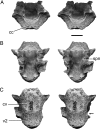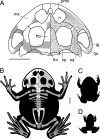A giant frog with South American affinities from the Late Cretaceous of Madagascar
- PMID: 18287076
- PMCID: PMC2268566
- DOI: 10.1073/pnas.0707599105
A giant frog with South American affinities from the Late Cretaceous of Madagascar
Abstract
Madagascar has a diverse but mainly endemic frog fauna, the biogeographic history of which has generated intense debate, fueled by recent molecular phylogenetic analyses and the near absence of a fossil record. Here, we describe a recently discovered Late Cretaceous anuran that differs strikingly in size and morphology from extant Malagasy taxa and is unrelated either to them or to the predicted occupants of the Madagascar-Seychelles-India landmass when it separated from Africa 160 million years ago (Mya). Instead, the previously undescribed anuran is attributed to the Ceratophryinae, a clade previously considered endemic to South America. The discovery offers a rare glimpse of the anuran assemblage that occupied Madagascar before the Tertiary radiation of mantellids and microhylids that now dominate the anuran fauna. In addition, the presence of a ceratophryine provides support for a controversial paleobiogeographical model that posits physical and biotic links among Madagascar, the Indian subcontinent, and South America that persisted well into the Late Cretaceous. It also suggests that the initial radiation of hyloid anurans began earlier than proposed by some recent estimates.
Conflict of interest statement
The authors declare no conflict of interest.
Figures





References
-
- Krause DW, et al. Late Cretaceous terrestrial vertebrates from Madagascar: Implications for Latin American biogeography. Ann Mo Bot Gard. 2006;93:178–208.
-
- Smith AG, Smith DG, Funnel BM. Atlas of Mesozoic and Cenozoic coastlines. Cambridge, UK: Cambridge University; 1994.
-
- Hay WW, et al. Alternative global Cretaceous paleogeography. In: Barrera E, Johnson CC, editors. Evolution of the Cretaceous Ocean-Climate System. Boulder, CO: Geological Society of America; 1999. pp. 1–47. Special Paper 33.
-
- Krause DW, Hartman JH, Wells NA. Late Cretaceous vertebrates from Madagascar. Implications for biotic changes in deep time. In: Goodman SM, Patterson DB, editors. Natural Change and Human Impact in Madagascar. Washington, DC: Smithsonian Institution; 1997. pp. 3–43.
-
- Vences M. Origin of Madagascar's extant fauna: A perspective from amphibians, reptiles and other nonflying vertebrates. Ital J Zool Suppl. 2004;2:210–228.
Publication types
MeSH terms
LinkOut - more resources
Full Text Sources

